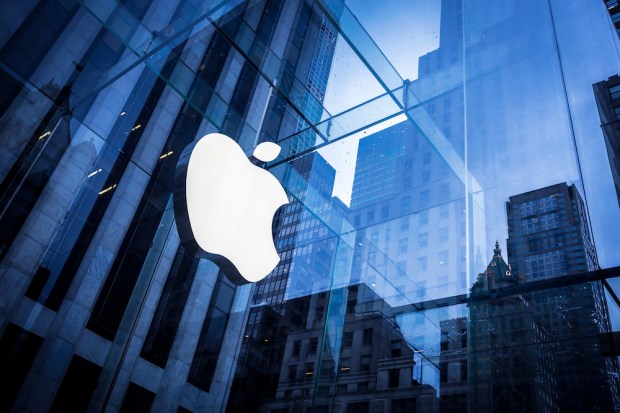Another So-So Earnings Report For Apple

It would be unfair to to call Apple’s latest earnings report a disaster or a huge miss. Apple did beat expectations on earnings and iPhone units sold. But given that Apple has now reported its third consecutive quarter of year-over-year declines pretty much across the board, it is getting hard to argue that Apple doesn’t have something of a gravity problem right now. For all the investor enthusiasm — the release of the iPhone 7 has pushed Apple’s stock price to the highest place it’s been in 2016 — Apple can’t seem to keep its numbers from getting pulled back to Earth.
Which is not to say that CEO Tim Cook was less enthused than normal. In the quarterly call with investors, Cook was his normal, thrilled self.
“Our strong September quarter results cap a very successful fiscal 2016 for Apple,” Cook noted. “We’re thrilled with the customer response to iPhone 7, iPhone 7 Plus and Apple Watch Series 2, as well as the incredible momentum of our Services business, where revenue grew 24 percent to set another all-time record.”
As is also usual, opinions split on the results. Macworld noted that Apple was “making lemonade” out of another batch of sour earnings. Jim Cramer — CNBC’s infinitely excitable investment guru — thinks that Wall Street just fundamentally isn’t getting the point, particularly when it comes to the one part of the earnings call that did see big growth: Apple’s expanding Services business.
So, are the naysayers nitpicking Cupertino unduly, or are the Apple boosters engaging in magical thinking?
As always, with earnings, a little of both…
By The Numbers
Apple managed to beat analyst estimates on earnings per share ($1.67 vs. $1.66) but missed on revenue. Analysts were looking for $47 billion in revenue; Apple reported $46 billion. Both figures are below last year’s earnings and revenue figures of $1.96 a share on sales of $51.5 billion. Net income fell 19 percent to $9 billion when compared to the same period a year earlier.
The iPhone accounted for 63 percent of Apple’s revenue in the just-completed fiscal year, and though iPhone sales were slightly better than expected, the reported number ended up being 45.5 million — the expected was 45 million. That is still 2.5 million fewer iPhones sold than the same time period a year ago.
And the rest of the product line wasn’t looking all that much stronger. Mac computer sales fell 17 percent from a year earlier. IPad sales, which have fallen in recent years, were flat. Sales of Apple’s “other products” category, which include the Apple Watch, fell 22 percent from the same time in 2015.
Sales of Apple products are slowing down in the U.S., largely due to market saturation of Apple’s core product, the iPhone. Sales in China have also plummeted, falling 30 percent year to year during the final quarter of Apple’s fiscal year.
Investors, it seems, did not ultimately like what they heard in all those declines. Apple’s stock nudged up initially in after-hours trading but opened the markets down 2 percent this morning.
On The Bright Side Of Things
There is plenty of touting to do with these numbers, and Apple certainly made the most of them. Even with the 9 percent decline in net income, at $47.5 billion, Apple is still the most profitable company on Earth. The company reported holding $237.6 billion in cash and investments, up from $231.5 billion three months earlier.
Outside of China and the U.S., where sales are declining, sales are up — just not by enough to outweigh those giant economies.
Apple also has the benefit of selling phones that are not known, at least yet, for catching on fire, nor did it have to remove the iPhone 7 from the marketplace entirely — two things its chief rival, Samsung, can’t quite say at the moment. And Cook has obliquely acknowledged that Samsung’s loss is Apple’s gain.
“We’ve had a large number of Android switchers that are looking for better experiences. We want to offer anybody who would like to come over a great experience.”
A great experience that includes Apple’s Services lineup — home of Apple Pay, Apple Music and the App Store — which was the major area that bucked the decline trend and showed solid 24 percent year-to-year growth. Cook called it “our huge highlight in the quarter.”
“To me, once again, the exceedingly profitable revenue stream is the one to watch, and it is still being relatively ignored, despite its 24 percent growth to $6.3 billion and despite the naysayers’ comments,” CNBC’s Jim Cramer noted — before advising Apple shareholders to hold the stock instead of trading it. But Services is still a very small portion of the P&L, and it isn’t clear that Apple has a strategy for using it to make up for the declining hardware business.
The best news Apple had to report, however, was not about the quarter that ended but about the one that is yet to come.
Apple projected revenue of $76 billion–$78 billion in the current quarter, which includes the holiday shopping season and sales of the new phone. That would be an increase from $75.9 billion in the same period a year earlier and an increase on analysts’ average projections of $74.9 billion.
Will it make it?
Hard to say. Apple’s hit some rough sledding, and it remains to be seen if consumers will be as bullish on the iPhone 7 as Tim Cook is. But with Samsung out of the picture and Google’s high-end phone new to the race, it seems next quarter is likely Apple’s best chance to to reverse its recent losing streak.
